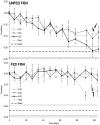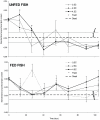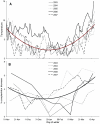Temperature and resource availability may interactively affect over-wintering success of juvenile fish in a changing climate
- PMID: 21998627
- PMCID: PMC3188530
- DOI: 10.1371/journal.pone.0024022
Temperature and resource availability may interactively affect over-wintering success of juvenile fish in a changing climate
Abstract
The predicted global warming may affect freshwater systems at several organizational levels, from organism to ecosystem. Specifically, in temperate regions, the projected increase of winter temperatures may have important effects on the over-winter biology of a range of organisms and especially for fish and other ectothermic animals. However, temperature effects on organisms may be directed strongly by resource availability. Here, we investigated whether over-winter loss of biomass and lipid content of juvenile roach (Rutilus rutilus) was affected by the physiologically relatively small (2-5 °C) changes of winter temperatures predicted by the Intergovernmental Panel on Climate Change (IPCC), under both natural and experimental conditions. This was investigated in combination with the effects of food availability. Finally, we explored the potential for a correlation between lake temperature and resource levels for planktivorous fish, i.e., zooplankton biomass, during five consecutive winters in a south Swedish lake. We show that small increases in temperature (+2 °C) affected fish biomass loss in both presence and absence of food, but negatively and positively respectively. Temperature alone explained only a minor part of the variation when food availability was not taken into account. In contrast to other studies, lipid analyses of experimental fish suggest that critical somatic condition rather than critical lipid content determined starvation induced mortality. Our results illustrate the importance of considering not only changes in temperature when predicting organism response to climate change but also food-web interactions, such as resource availability and predation. However, as exemplified by our finding that zooplankton over-winter biomass in the lake was not related to over-winter temperature, this may not be a straightforward task.
Conflict of interest statement
Figures




Similar articles
-
Fish-mediated plankton responses to increased temperature in subtropical aquatic mesocosm ecosystems: Implications for lake management.Water Res. 2018 Nov 1;144:304-311. doi: 10.1016/j.watres.2018.07.055. Epub 2018 Jul 23. Water Res. 2018. PMID: 30071399
-
Combined effects of turbulence and different predation regimes on zooplankton in highly colored water-implications for environmental change in lakes.PLoS One. 2014 Nov 6;9(11):e111942. doi: 10.1371/journal.pone.0111942. eCollection 2014. PLoS One. 2014. PMID: 25375952 Free PMC article.
-
Interactions between predation and resources shape zooplankton population dynamics.PLoS One. 2011 Jan 31;6(1):e16534. doi: 10.1371/journal.pone.0016534. PLoS One. 2011. PMID: 21304980 Free PMC article.
-
Ecology under lake ice.Ecol Lett. 2017 Jan;20(1):98-111. doi: 10.1111/ele.12699. Epub 2016 Nov 27. Ecol Lett. 2017. PMID: 27889953 Review.
-
Tropicalization of temperate ecosystems in North America: The northward range expansion of tropical organisms in response to warming winter temperatures.Glob Chang Biol. 2021 Jul;27(13):3009-3034. doi: 10.1111/gcb.15563. Epub 2021 Mar 17. Glob Chang Biol. 2021. PMID: 33605004 Review.
Cited by
-
Population structure and genome-wide evolutionary signatures reveal putative climate-driven habitat change and local adaptation in the large yellow croaker.Mar Life Sci Technol. 2023 Apr 7;5(2):141-154. doi: 10.1007/s42995-023-00165-2. eCollection 2023 May. Mar Life Sci Technol. 2023. PMID: 37275538 Free PMC article.
-
Identification of supraoptimal temperatures in juvenile blueback herring (Alosa aestivalis) using survival, growth rate and scaled energy reserves.Conserv Physiol. 2022 Apr 20;10(1):coac022. doi: 10.1093/conphys/coac022. eCollection 2022. Conserv Physiol. 2022. PMID: 35492413 Free PMC article.
-
Gluconeogenesis during starvation and refeeding phase is affected by previous dietary carbohydrates levels and a glucose stimuli during early life in Siberian sturgeon (Acipenser baerii).Anim Nutr. 2017 Sep;3(3):284-294. doi: 10.1016/j.aninu.2017.06.001. Epub 2017 Jun 15. Anim Nutr. 2017. PMID: 29767079 Free PMC article.
-
Emergence of a novel prey life history promotes contemporary sympatric diversification in a top predator.Nat Commun. 2015 Sep 14;6:8115. doi: 10.1038/ncomms9115. Nat Commun. 2015. PMID: 26365323
-
Short winters threaten temperate fish populations.Nat Commun. 2015 Jul 15;6:7724. doi: 10.1038/ncomms8724. Nat Commun. 2015. PMID: 26173734 Free PMC article.
References
-
- Gerten D, Adrian R. Climate driven changes in spring plankton dynamics and the sensitivity of shallow polymictic lakes to the North Atlantic Oscillation. Limnology & Oceanography. 2000;45:1058–1066.
-
- George G, Hurley M, Hewitt D. The impact of climate change on the physical characteristics of the larger lakes in the English Lake District. Freshwater Biology. 2007;52:1647–1666.
-
- Meehl GA, Stocker TF, Collins WD, Friedlingstein P, Gaye AT, et al. Cambridge: Cambridge University Press; 2007. Global Climate Projections, Climate Change 2007: The Physical Science Basis. Contribution of Working Group I to the Fourth Assessment Report of the Intergovernmental Panel on Climate Change. pp. 747–845.
-
- Walter G-R, Post E, Menzel A, Parmesan C, Beebee TJC, et al. Ecological responses to recent climate change. Nature. 2002;416:389–395. - PubMed
-
- Carpenter SR, Kitchell JF. Cambridge: Cambridge University Press; 1993. The trophic cascade in lakes.
Publication types
MeSH terms
LinkOut - more resources
Full Text Sources
Medical

